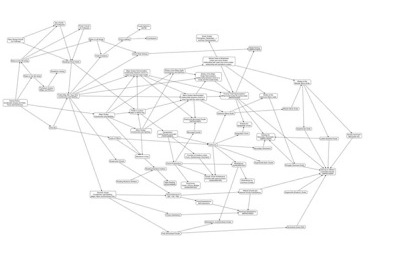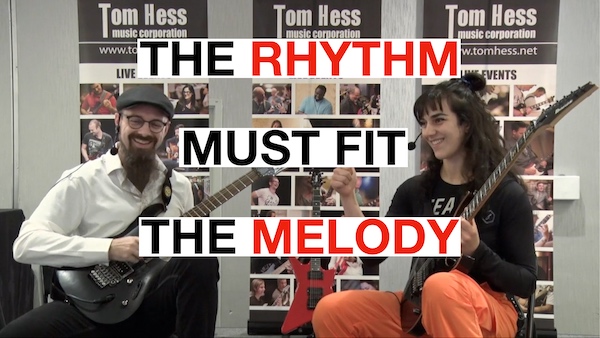Write RHYTHM Guitar Parts That Fit Your MELODY Right


Have you ever come up with a great melody, and maybe you even have a chord progression that it will fit with...
...but you have no idea how to play those chords in a way that works with your melody?
It happens all the time! Even if a chord progression works totally fine with the melody, without an interesting way of playing it rhythmically, the whole thing just kind of falls flat.
If we want the melody to really stand out and for the song as a whole to be memorable, it can’t just be the melody that’s interesting. The rhythm underneath needs to support the melody and be catchy in and of itself if we want to create something great.
But where do you even begin with this?
There are limitless options for how to play a chord progression, and if you don’t know what will work, how can you possibly find the right option?
Trial and error? (Yeah, sure...)
Well, there’s actually a really simple way to start getting some very good ideas.
If you already have a melody, the rhythm of that melody can serve as a point of inspiration for how to play the chords. If we want the rhythm to compliment the melody, then it just makes sense that the rhythm should directly relate to the melody.
So how should you actually go about doing this? You can't take the exact same rhythm of the melody if you want to complement the melody, after all!
So what does this process look like and more importantly, what does it sound like?
In the video linked below, I’ll be going over every step of the process to write a rhythm that accompanies a melody and showing you exactly what this method can sound like.
Want to know more about rhythm guitar playing and coming up with rhythm guitar parts? One very important concept is to know as much as possible about chords. Check out my Complete Chord Mastery guitar course if you want to learn more about chords and start writing better rhythm guitar parts.
Video Transcription
Hello, Internet, so nice to see you. Let's say you have an idea for a melody and you want to make a song out of it, but a melody alone does not really make a song, does it? There are other things you need to put in to make a song, and one of the most important things is how do you accompany that melody? And whether you want to play under that melody, and I'm not talking only about what chords you want to play, which is important, but definitely not the only thing.
Right now, I'm thinking, especially what rhythm will fit the melody? What kind of accompanying rhythm will support the melody, complement the melody, and make it shine? So here is a little songwriting secret just right out of the bat, okay? The accompanying rhythm can make or break your melody. It's absolutely important that you get that right. So, a student asked me how to match an accompanying rhythm with a melody, and here's what I answered.
I find it very easy to come up with vocal melodies or whatever, a melody, but it's not very easy to come up with a rhythm guitar part that sounds rhythmically interesting, aka not boring and average, that it's going to complement that and also bring out some of the emotion or the mood that I want to convey with that particular melody. Because we all know a melodic line, you could put so many different kind of harmonies behind that, but I think part of what makes the vocal melody interesting is the rhythm that goes behind it, especially if you're into some more aggressive music.
Okay, so do you have any example or you want to come up with a melody?
We could just come up with one.
Let's come up with the melody. So what's your playing there?
Yeah, so we'll do...
So, actually, this is where...
Something extra afterwards?
It could be this, I mean... So you're hitting a C on the top note there.
Mm-hmm
Okay, let's get the first part. So the first thing I will do, well first I will find the chords, honestly, but right now I think we have something decent enough, and it seems a bit.
Then I will start, I will write the melody down, like on a score, if you know the answer, and then look only at the note value. So now I'm taking the rhythm from the melody.
Okay, gotcha.
Okay Why am I doing that because I don't want to come up with a rhythm completely independent from the melody You want a rhythm that complements the melody Compliments. Yeah, you want Rhythm that expresses the same emotion at the melody because you want to support that specific melody Yeah, okay If you want something contrasting we can do it But we have to start by knowing what the melody is right the rhythm of the melody in particular because Yeah You have essentially a triplet here
Yeah.
and a quarter note, essentially, or a half note, depending on how you play. Makes sense. So play it again.
you
It's actually a dotted half-note, okay. So you have a triplet and a dotted half-note, okay. So now we have two elements to work from, okay.
And notice that both those elements have the number three inside. A triplet has three notes in a bit. A dotted half-note is three bits.
Mm-hmm.
Okay, and so now I'm thinking, okay, so my melody contains this element of 3, okay? Notice that I'm doing this on real time because he just invented the melody. We didn't talk about this before. You can do this kind of consideration with any melody.
You break down and you just see the rhythm. And we discovered that typically the melody repeats some rhythms or some motif, rhythmical motif here and there, okay? That's the first thing you want to do. Second, now you want a rhythm that complements the melody. So you have two possible ways.
You do something that comes from the melody or you go against the melody. Typically, you do something that comes from the melody because you want something with the same feeling. Occasionally, you want to do something that goes against the melody if you really want to express something like conflict, strife, okay? Or you want to push the melody in a completely different direction. But right now, we're not doing that because that requires a lot more time to do, okay?
So you have a triplet and a dotted half note. Again, elements of 3. So first of all, I will start thinking of my rhythm using triplets. I could use full triplets. I can eliminate the triplet, but I'm thinking triplets. And what I'm going to do is I'm going to play those triplets when the melody is not playing the triplet, okay?
So your melody is playing the triplet on beat number 4. Because it's 4 and 1. Right? Or whatever. You guys will notice very soon that when I sing, it's like I'm tone deaf. I cannot hit a pitch to save my life. Okay, good. So that's 4, 1, 2, 3. And then you're doing...
Yeah, so much.
On the 4th beat, she does that. So I will displace it by half bar just to start. Okay. So you're going... So you play the melody? Okay.
Makes sense, so she's putting the triplet on the fourth bit. I'm putting the triplet on the second bit, half a bar away. Feels pretty good, no? Okay. Now, you may notice that many of you will play the exact same thing by instinct. Okay. What do you get there by reasoning or by instinct? It's fine, not a problem.
Okay. Now, we can think, do I want something more interesting? Of course, it's a yes. Okay. So I'll start moving the triplet around. Now, at this point, I can hit any level of complexity. I'm putting the triplet always on the first beat, always in the third beat, always in the second beat, or the first bar I'm putting it on beat one, the second bar I'm putting it on beat two, the third bar. Or I'm going to do any kind of scheme you can have in your mind. I'm just going to put a triplet somewhere. Right. Okay. So right now, why don't we try something like that? I'm going to put the triplet on the first bit of bar I and the second bit of bar 2, just because. And let's see how it goes.
Okay. You go. Make sense? You may like it. You may not like it. The idea is to have options right now and see how it goes on. Okay. Yeah. Next thing, we could start thinking, why don't we change what kind of triplets? So this is a triplet of, it's an eighth note triplet. But I could put a quarter note triplet. It's a bit harder to play.
Okay. Because there are half the speed of what she's doing. So I'm going to get confused when I'm doing it. I know. But we can try that. Okay. So let's see if I can do that. Go for it. Okay. So you can feel that she has the fast triplet. I have this low triplet and there is kind of friction going on between the two. So I just took the triplet and simply doubled the length of the triplet, all the note values of the triplet. So that's the idea.
You don't start from scratch. Right. You take the melody, you dissect the melody, whatever. You break the melody apart, take only the rhythm, and start thinking, hey, I'm using this rhythm element. Can I reuse the rhythm element in the rhythm? It's typically you take it and you shift it. You could take it and reverse it. But I mean, in this case, it's a triplet. Even if we reverse it, it's a triplet. Okay. Or I'm making it longer or I'm making it shorter. And I'm building the rhythm based on that. And I try to find something that doesn't conflict with the melody. So when the melody has a triplet, I'm putting a long note. And when the melody is a long note, I'm putting the triplet. Yeah.
And you're giving me an idea with this too, like let's say you wanted to make it a little bit more aggressive I don't know what chord were you playing there. D minor and then G minor. Okay, so let's say Sorry D D minor and G minor.
Okay so let's say we kept the triplet going like palm muted the whole time steady triplets but we accented like different parts that where the melody is not playing you would do like an accent i don't know like kind of like that.
Yep. Okay. Now what happens typically is that you get something from the melody, you think about it, you put it on paper, then you hear it, then you start feeling it, then you start changing it by feeling, but you got started.
Yes. Okay. It doesn't have to be done completely by theory or completely by feeling.
The theory gives you an idea of two or three, and then you start feeling it, and then you know the rhythm. Make sense?
Yeah. Totally. Good. Fantastic.